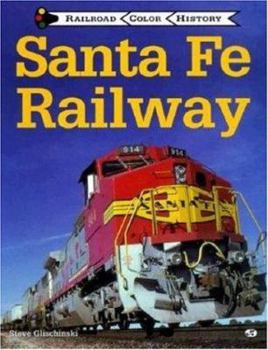Santa Fe Railway
Select Format
Select Condition 
Book Overview
A classic and colorful tribute to the Atchison, Topeka and Santa Fe Railway, the best-known railroad in the world. Beginning in 1860, the Atchison, Topeka and Santa Fe Railway quickly grew to become... This description may be from another edition of this product.
Format:Paperback
Language:English
ISBN:0760303800
ISBN13:9780760303801
Release Date:November 1997
Publisher:Voyageur Press (MN)
Length:128 Pages
Weight:1.20 lbs.
Dimensions:0.4" x 8.2" x 10.6"
Customer Reviews
4 ratings
The Santa Fe Way
Published by Thriftbooks.com User , 21 years ago
"Santa Fe Railway"Steve GlischinskiISBN 0-7603-0380-0It would seem that this book was written for railroad enthusiasts. It is not without facts about engine model numbers and wheel configurations, but more importantly it also brings back the feel of the glory days of one of the most famous railroads in American history. My interest is more in the latter. My dad worked for the Santa Fe as a switchman. My family was a railroad family. At night, we heard the boxcars being banged together in yards not far from our house. I can remember standing on the front porch, as a small boy, to watch the "Texas Chief" approach.A particularly interesting chapter in this book deals with Fred Harvey's remarkable success in his food service business with the Santa Fe Railroad. Prior to Harvey, food at railroad restaurants was notoriously bad. In 1876, Harvey approached the Santa Fe. He was given a try. He succeeded by providing fine meals and service at his first location in Topeka. The Santa Fe asked him to open more restaurants at train stations further west. Within a few years, he had branched off into building hotels for railroad employees, but eventually for the general public. His restaurants and hotels went from Kansas to California. One of Harvey's most popular hotels was at the Grand Canyon. Harvey's restaurants were staffed by attractive young women of good character relocated from the East to work in his establishments. The "Harvey Girls" lived in supervised dormitories he provided. Ultimately, Harvey relocated over 5,000 young women. Many of whom married and remained in the West. When the Santa Fe started providing dining cars on its trains in the 1890's, Harvey received a contract for that as well. The book has a photograph of a dining car menu from the 1960's that is certainly nostalgic to read.Railroading was an extremely competitive business, about which one could draw parallels to the present day computer industry. For one thing, railroads were about technology. The railroad that had the fastest and most powerful locomotives had a competitive business advantage over the others. As with computer companies, no advantage held up for long. The Santa Fe was constantly innovating, such as when it began trying out diesel locomotives. The Santa Fe was not above employing technological stunts to get publicity, such as when in 1905 it accepted a challenge to get a train from Los Angeles to Chicago in 46 hours. The three-car, so-called "Coyote Special" made it under 45 hours. Railroads, also like computer companies, often sought to acquire other railroads, the ultimate fate of the Santa Fe when acquired by the Burlington Northern in 1996. But the Santa Fe ran for over a hundred years.This book brought back a lot of good memories for me. It may for others as well.
Very good for rookie railfans
Published by Thriftbooks.com User , 22 years ago
I got this book a couple weeks ago and immediatly was hooked. It's nicely written, has alot of steam plus enough diesel piccies to keep me happy. A nice history of the Harvey services also included. I'm a rookie railfan, and I learned TONS from this book. SF & BNSF are my favorites, nothing compares to the warbonnet. Most of the book is all history from day one to the merger with Burlington Northern. Then it covers the steamers and diesels in their own chapters. Well worth buying.
One book you should have in your collection
Published by Thriftbooks.com User , 25 years ago
The book is very well presented with a large range of colour (and black & white) photo's. The layout is easy to follow and the text flows well. It provides a good background on The Santa Fe.My only concern is that I have found some of the historical facts differ from other material I have. This is dissapointing because I am now not sure of how many other facts could be different or incorrect.Overall, Steve has done a very good job with the book and it is one that should be on your bookshelf and read a lot.Brendon.
A nice history of perhaps the most famous American RR
Published by Thriftbooks.com User , 25 years ago
This book covers every aspect of the Atchison Topeka and Santa Fe Railway from its beginnings in 1868 to its merger with Burlington Northern in 1995-96. The various chapters cover segments of that history, with others on Passenger trains and Santa FE's steam and diesel locomotives. Of particular interest are Santa Fe's growth and acquisition of important rail routes, its pioneering role in development of intermodal traffic, and its passenger service which was second to none. Who could not help falling in love with those Warbonnet E- and F-units pulling stainless steel coaches! Modern diesels (not including AC types) are covered as well. There is a photo (or a map) on nearly every page, mostly color, with some nice old black-and-whites. The pages are laid out well with a minimum of blank space, and the text is well-written and very readable without being overly technical. On pages 8-9 a 1967 system map shows Santa Fe's major routes with many connecting ones of other railroads; just looking at brings back memories of railroads long gone (Rock Island, Milwaukee Road, Frisco, even Pennsylvania).While this book may be a bit pricey for a softcover, it's sure to please. If it doesn't make you a Santa Fe fan, probably nothing will. --- Paul H!





